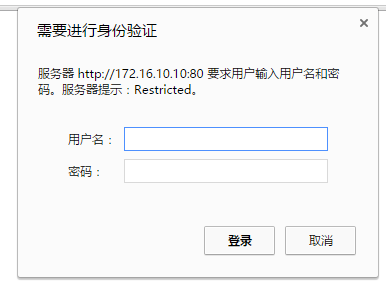Nginx实现浏览器可实时查看访问日志的步骤详解
一、首先查看nginx版本,我使用的是1.9.7的版本,安装目录在/application/nginx-1.9.7
[root@AnSheng ~]# /application/nginx-1.9.7/sbin/nginx -V nginx version: nginx/1.9.7 built by gcc 4.4.7 20120313 (Red Hat 4.4.7-16) (GCC) configure arguments: --prefix=/application/nginx-1.9.7 --user=nginx --group=nginx --with-http_stub_status_module
二、检查语法并启动nginx
[root@AnSheng ~]# /application/nginx-1.9.7/sbin/nginx -t nginx: the configuration file /application/nginx-1.9.7/conf/nginx.conf syntax is ok nginx: configuration file /application/nginx-1.9.7/conf/nginx.conf test is successful [root@AnSheng ~]# /application/nginx-1.9.7/sbin/nginx
三、把nginx配置文件内多余的注视行和空行删掉
[root@AnSheng ~]# cd /application/nginx-1.9.7/conf/
[root@AnSheng conf]# egrep -v "#|^$" nginx.conf.default
worker_processes 1;
events {
worker_connections 1024;
}
http {
include mime.types;
default_type application/octet-stream;
sendfile on;
keepalive_timeout 65;
server {
listen 80;
server_name localhost;
location / {
root html;
index index.html index.htm;
}
error_page 500 502 503 504 /50x.html;
location = /50x.html {
root html;
}
}
}
[root@AnSheng conf]# egrep -v "#|^$" nginx.conf.default nginx.conf
四、在nginx配置文件的server标签内加入以下标签和内容
location /logs {
alias /application/nginx-1.9.7/logs;
#Nginx日志目录
autoindex on;
#打开目录浏览功能
autoindex_exact_size off;
#默认为on,显示出文件的确切大小,单位是bytes
#显示出文件的大概大小,单位是kB或者MB或者GB
autoindex_localtime on;
#默认为off,显示的文件时间为GMT时间。
#改为on后,显示的文件时间为文件的服务器时间
add_header Cache-Control no-store;
#让浏览器不保存临时文件
}
五、开启在浏览器打开log文件,如果不开启再点击文件的时候就下载而不是打开
[root@AnSheng conf]# vim mime.types
types {
text/html html htm shtml;
text/log log;
text/css css;
text/xml xml;
.............
六、检测语法,然后让nginx配置生效,在浏览器查看
[root@AnSheng conf]# /application/nginx-1.9.7/sbin/nginx -t nginx: the configuration file /application/nginx-1.9.7/conf/nginx.conf syntax is ok nginx: configuration file /application/nginx-1.9.7/conf/nginx.conf test is successful [root@AnSheng conf]# /application/nginx-1.9.7/sbin/nginx -s reload
打开浏览器输入域名或者IP,后面加上logs,然后点击文件就可以打开了,如果日志随随便便就可以被别人查看是不是很不安全,所以我们要在加一层nginx用户认证。


七、安装httpd-tools,用于帐号密码生成
[root@AnSheng ~]# yum -y install httpd-tools
八、创建认证的账号
[root@AnSheng ~]# htpasswd -c /application/nginx-1.9.7/conf/loguser loguser New password: Re-type new password: Adding password for user loguser #密码需要输入两次
九、编辑nginx配置文件,在logs的location加入下面的内容
location /logs {
......
alias PATH;
autoindex on;
autoindex_exact_size off;
autoindex_localtime on;
add_header Cache-Control no-store;
auth_basic "Restricted";
#Nginx认证
auth_basic_user_file /application/nginx-1.9.7/conf/loguser;
#认证账号密码保存的文件
}
十、然后再打开的时候就会提示输入账号和密码,登陆之后才可以查看。

十一、总结
以上就是利用Nginx实现浏览器可实时查看访问日志的全部步骤,希望对大家的学习或者工作有所帮助,如果有疑问大家可以留言交流。
相关文章
详解nginx同一端口监听多个域名和同时监听http与https
这篇文章主要介绍了详解nginx同一端口监听多个域名和同时监听http与https的相关资料,需要的朋友可以参考下...2017-07-06- 这篇文章主要介绍了Nginx根据不同浏览器语言配置页面跳转的方法,包括一个简体繁体的基本判断方法及实际根据中英文跳转的例子,需要的朋友可以参考下...2016-05-22
- 周一今天给大家分享shell脚本多实例部署nginx的详细教程,文章通过实例代码脚本给大家详细介绍,对大家的学习或工作具有一定的参考借鉴价值,需要的朋友参考下吧...2021-10-26
- 这篇文章主要介绍了Nginx中配置过滤爬虫的User-Agent的简单方法,文中罗列了一些常用搜索引擎的爬虫名称以免造成不必要的过滤,需要的朋友可以参考下...2016-01-27
- 这篇文章主要介绍了nginx配置引发的403问题解决办法的相关资料,需要的朋友可以参考下...2017-07-06
- 这篇文章主要介绍了Linux环境下nginx搭建简易图片服务器,需要的朋友可以参考下...2016-01-27
- 这篇文章主要介绍了Nginx访问日志及错误日志参数说明,文中通过示例代码介绍的非常详细,对大家的学习或者工作具有一定的参考学习价值,需要的朋友可以参考下...2020-11-14
- 这篇文章主要介绍了使用nginx方式实现http转换为https的示例代码,文中通过示例代码介绍的非常详细,对大家的学习或者工作具有一定的参考学习价值,需要的朋友们下面随着小编来一起学习学习吧...2020-09-06
Nginx反向代理proxy_cache_path directive is not allowed错误解决方法
这篇文章主要介绍了Nginx反向代理proxy_cache_path directive is not allowed错误解决方法,需要的朋友可以参考下...2016-01-27nginx+apache+mysql+php+memcached+squid搭建集群web环境
当前,LAMP开发模式是WEB开发的首选,如何搭建一个高效、可靠、稳定的WEB服务器一直是个热门主题,本文就是这个主题的一次尝试。...2016-01-27- Nginx日志主要分为两种:访问日志和错误日志。访问日志主要记录客户端访问Nginx的每一个请求,格式可以自定义。下面这篇文章主要给大家介绍了Nginx自定义访问日志的配置方式,需要的朋友可以参考学习,下面来一起看看吧。...2017-07-06
- 这篇文章主要介绍了nginx使用IPV6的相关配置项介绍,首先查看编译参数是否编译了IPV6模块,然后介绍了监听IPV6的配置语法,需要的朋友可以参考下...2016-01-27
解决使用了nginx获取IP地址都是127.0.0.1 的问题
这篇文章主要介绍了解决使用了nginx获取IP地址都是127.0.0.1 的问题,获取i工具的完整代码文中给大家提到,具体实例代码跟随小编一起看看吧...2021-09-18- 本篇文章主要介绍了nginx修改上传文件大小限制的方法,小编觉得挺不错的,现在分享给大家,也给大家做个参考。一起跟随小编过来看看吧。 ...2017-01-22
- 这篇文章主要介绍了Debian7编译安装nginx简明教程,本文直接给出操作命令和步骤,需要的朋友可以参考下...2016-01-27
- 这篇文章主要介绍了隐藏Nginx或Apache以及PHP的版本号的方法,主要用来防止针对性的漏洞攻击,需要的朋友可以参考下...2016-01-05
php性能分析之php-fpm慢执行日志slow log用法浅析
这篇文章主要介绍了php性能分析之php-fpm慢执行日志slow log用法,结合实例形式分析了php慢执行日志的功能与相关使用技巧,需要的朋友可以参考下...2016-10-20- 这篇文章主要介绍了Nginx DNS resolver配置实例,本文讲解在proxy_pass 和 upstream server 通信的时候需要手动指定 resolver,本文就给出了配置实例,需要的朋友可以参考下...2016-01-27
- 这篇文章主要介绍了关于Nginx中if语句的判断条件与多条件判断的相关资料,文中给出了详细的示例代码,对大家具有一定的参考价值,需要的朋友们下面来一起看看吧。...2017-07-06
详解Nginx服务器中配置Sysguard模块预防高负载的方案
这篇文章主要介绍了详解Nginx服务器中配置Sysguard模块预防高负载的方案,该模块由阿里巴巴的团队开发,能够设置负载阀值,比较强大,需要的朋友可以参考下...2016-02-02
